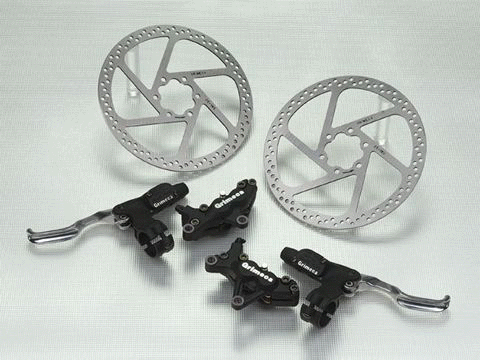Disk Brakes
Disk Brakes vs V brakes
Disk brakes stop better in adverse conditions and have
better modulation. They do not wear the rims, brakes still
work if your wheels are out of true, pads last longer and are
low maintenance. Four piston brakes do not chatter, two
piston brakes might chatter during braking.
Brands I'd consider are Hope, Hayes, Shimano/Grimeca.
Originally, I was all set to buy the Hopes 4 piston xc
brakes but I found out that they are only compatible with
Hope hubs due to spoke clearance at the caliper. The XC
rotors are smaller than the DH rotors, so the caliper sits
closer to the hub. Warnings against usage with Chris King
Discotek hubs at this site.
And at the UK Wheelpro site.
Note: Chris King disk adaptor instructions specifically
warns against using a Hope rotor other than the 180 mm rotor
on the front Discotek hub. In addition, if using Hope brakes,
CK recommends building the front wheel with an asymetrical
rim to better offset the spokes.
Someone, in England, has told me since that this is not
true and adapters exist for most hubs. I haven't found any
adapters at the US Hope site.
If anyone has Hope XC's working with Chris King Discotek
hubs, I'd be interested to know how its done.
Anyways, I ended up selecting the Grimeca disks because
they work with the Chris King Discotek hubs and are much
cheaper ($300 per set, front and back).

Front Disk
The front disk brake assembly consists of a handlebar lever,
fluid reservoir, brake line, disk caliper and disk rotor. The
lever and reservoir attaches to the handlebar, the disk brake
caliper attaches to the left leg of the front fork and the disk
brake rotor attaches to the front hub.
There are different standards for the attachment point,
international (ISO) and Hayes. Some bomber forks have an
international standard mount. You need to use a brake caliper
with a international standard mount or find an adapter to fit.
Make sure the fork, front hub and disk brake are compatible
before purchase. The 1999 Z1 bomber alloy has an international
mount. The Grimeca has also has an international mount.
The Grimeca rotor has a Hayes compatible bolt pattern. Your
front hub must be Hayes compatible or have an adaptor to fit. The
Chris King Discotek hub has a Hayes compatible adaptor.
Grimeca System 8 Millenium Front Disk Brake Kit
The Grimeca system comes factory bled. Other than the
brake lever adjustment screw, there are no adjustment knobs.
Uses DOT 3 brake fluid.
Contains the following:
Right handlebar lever/reservoir assembly.
Vinyl coated braided stainless steel brake line, 150
bar rating
2 brake caliper mounting allen screws
6 rotor attachment screws/washers
1 disk rotor, 2mm thick x 160 mm diameter, Hayes
compatible
total weight of above items, including brake
fluid :425 gm
1 bag assorted shims
1 tube brake seal grease
1 cryptic italian-english owners manual
1 sticker
Rear Disk
Grimeca System 8 Millenium Rear Disk Brake Kit
The Grimeca system comes factory bled. Other than the
brake lever adjustment screw, there are no adjustment knobs.
Uses DOT 3 brake fluid.
Contains the following:
Left handlebar lever/reservoir assembly.
Vinyl coated braided stainless steel brake line, 150
bar rating
2 brake caliper mounting allen screws
6 rotor attachment screws/washers
1 disk rotor, 2mm thick x 160 mm diameter, Hayes
compatible
total weight of above items, including brake
fluid: 480 gm
1 bag assorted shims
1 tube brake seal grease
1 cryptic italian-english owners manual
1 sticker
Installation
Apply antiseize to brake caliper mounting screws. Attach
brake caliper to front fork. Torque to 5-7 Nm.
Remove rubber spacer between brake pads. Apply antiseize
to rotor attachment screws. Match rotor direction to wheel
rotation direction. Wipe rotor clean with rubbing alchol.
Using screws (with a touch of antiseize) and washers, attach
rotor to discotek adaptor. Add shims to the caliper mount to
center rotor in caliper, if necessary. (1 washer + 2 shims
works for me) Tighten screws/shims in X pattern. Torque to
5-7 Nm.
Tip: If rotor slightly rubs a pad
intermittently, place a sheet of white paper under the
caliper to spot which side the rotor is rubbing. Grip rotor
with CLEAN, NON GREASY hands and using gentle thumb pressure
to"true" your rotor.
Cable routing
Tip: The outer cable going from the rear
boss to the rear V brake will rub on the paint and wear
through it in a hurry. Clear ma-tak or another product called
"ski save" right under the cable is in order.
(submitted by David Houston)
Break in time
The brakes need to be broken in before they work properly.
Ride a few flat trails to let the pads bed in. Modulate the
brakes individually, dragging each brake to a stop (instead
of locking up) a few times is good enough to bring out the
power.
Bleeding brake procedure
Clamp bike in bike stand. Rotate bike until reservoir is
horizontal. Attach 18 " of clear PVC aquarium tube into
brake caliper outlet. Put other end in to clear glass jar,
fill jar about 1/4 full with DOT 3 brake fluid, enough to
cover free end of tube. Open caliper bleeding screw. Open
reservoir cover. Slowly squeeze brake lever,
pumping brake fluid and air bubbles into the clear PVC hose.
Keep reservoir full. When no more air bubbles appears in
tube, tighten caliper bleeding screw. Top up reservoir and
replace cover.
Changing brake pads
When 1mm of material is left on pad, it is time to change
your pads.
Cleaning parts
Use either alcohol or water to clean pump or caliper
parts. To avoid damaging the seals, DO NOT use gas or oil
products when cleaning the parts.
Back to Build